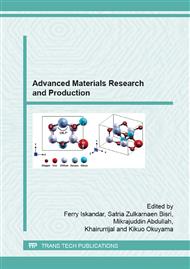p.406
p.410
p.414
p.421
p.425
p.429
p.433
p.437
p.441
Reduction of Harmful Substances in Cigarette Smoke Using TiO2 Nanoparticles
Abstract:
Both qualitative and quantitative effect of TiO2 suspension presence in cigarette filter have been analyzed in order to reduce harmful substances in cigarette smoke, optimizing the capability of TiO2 suspension as nano filter in cigarette filters and reviewing the analysis in order to obtain results with the best variation. Samples in the form of filter paper that has passed of the smoke with some variation treatment as it become ready to be tested and analyzed. Parameter such as concentration and volume variation of TiO2 suspension, and also the inputting method of TiO2 suspension into cigarette filter. Samples were characterized using FT-IR spectrophotometer and samples data absorbance obtained in each catchment area. The results showed that by reducing absorbance value percentage of each catchment area, with inputting method of TiO2 suspension through the cigarette filter tip and base, it appears that the most stable and lowest reduction present in C3 and H3, which is sample with 1.85 mol/liter concentration and 0.3 ml suspension volume. Both sample reduced particulate matters significantly after confirmed with X-Ray Fluorescence and SEM-EDS results, and was compared to sample filter without TiO2. Inputting method of TiO2 suspension through a base of cigarette butt is better and safer than through end of cigarette filter.
Info:
Periodical:
Pages:
425-428
Citation:
Online since:
July 2015
Keywords:
Price:
Сopyright:
© 2015 Trans Tech Publications Ltd. All Rights Reserved
Share:
Citation:


